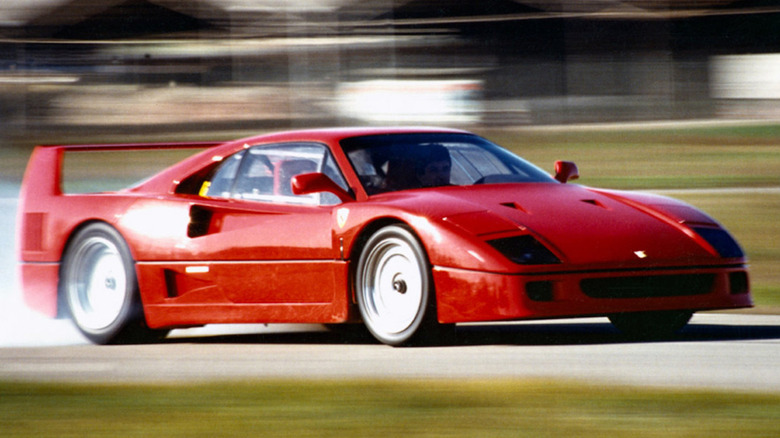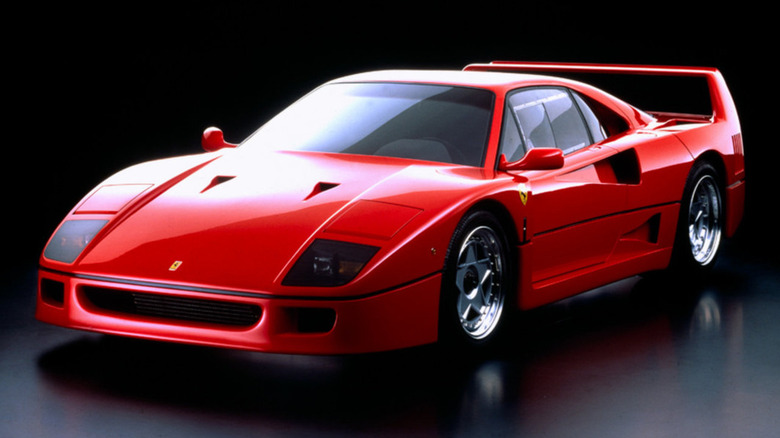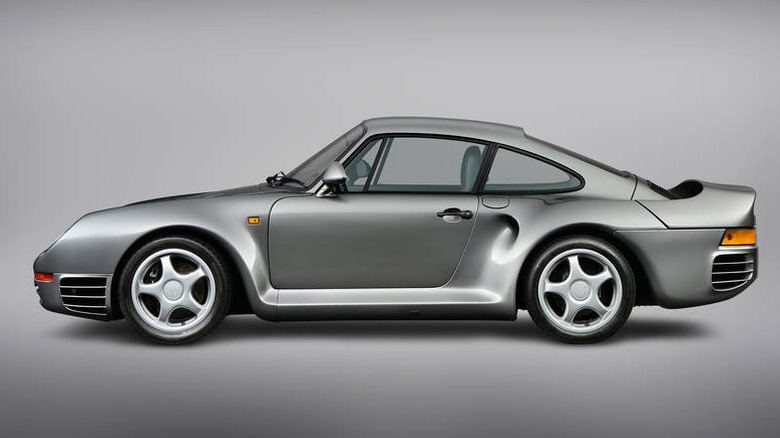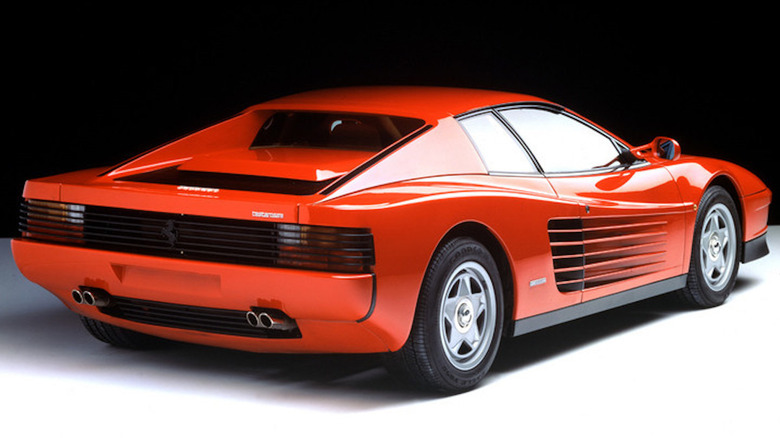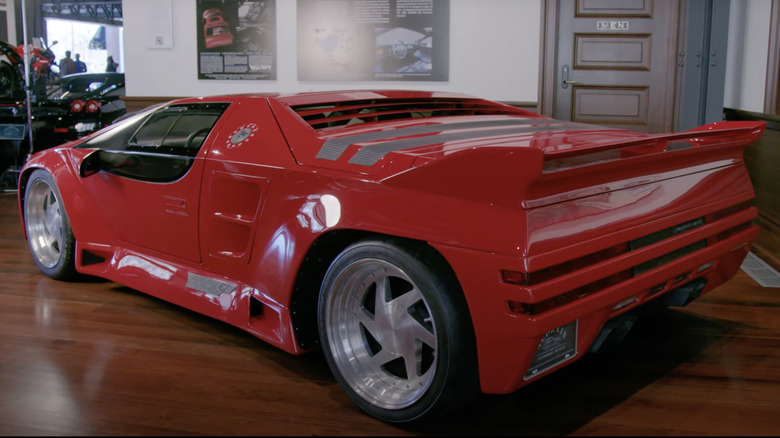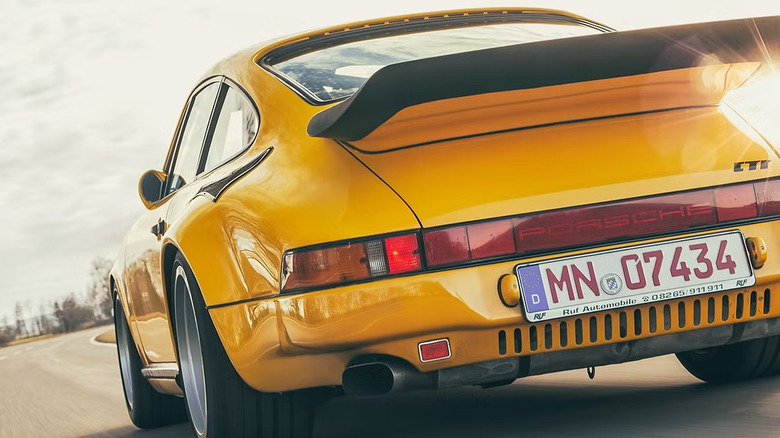5 Of The Highest Horsepower Sports Cars Of The 1980s
The 1980s aren't known for high horsepower cars. There are some epic high-horsepower muscle cars from that era, and lots of small, quirky cars (many of which qualify as awesome '80s cars), but there was definitely a lack of power in the 1980s. Horsepower numbers dropped off big time in the 1970s thanks to a number of factors. For example, the emissions restrictions, insurance cost increases for more powerful cars, a shift towards more fuel efficient cars thanks to the oil crisis, and the regulation of horsepower ratings by the Society of Automotive Engineers (SAE). And in the minds of many automotive enthusiasts, those restrictions carried over well into the 1980s, limiting the available power that could be had in just about any vehicle.
Thankfully, there are several exceptions to this perceived rule — perhaps even enough examples to prove the rule wrong. The 1980s had some pretty high horsepower cars. A surge in power came on with factors like turbocharging, particularly in the late 1980s, where there were several high-horsepower sports cars produced that are now cemented in our memories as some of the most iconic cars of all time. Their impressive powertrains stand the test of time, and they certainly place them on a pedestal during their own underpowered era.
Ferrari F40
You can call it a supercar, or you can call it a sports car, but no matter what you call it, it was iconic. The F40 was a celebration of the 40th anniversary of Ferrari, released in 1987, and it took the world by storm. The F40 was powered by a twin-turbocharged 2.9-liter V8 engine that produced 471 horsepower (it would later make 478 horsepower at a peak of 7,000 rpm). According to Ferrari's estimates, acceleration from zero to 100 kph (62 mph) took just 4.1 seconds. They also claimed that it had a top speed of 201 mph. Competition versions of the F40 still rank amongst the fastest cars Ferrari ever built to this day.
Lusting over the F40 isn't hard, either — it's widely considered one of the best-looking Ferraris of all time (and generally just one of the best Ferraris ever). It's also one of the most exclusive models you can buy with the Prancing Horse on the nose — Ferrari made just over 1,300 of them, with only 213 F40's destined for the United States. The rarity, the performance, and the beauty of the F40 all make it one of the most valuable supercars you'll find. An F40 sold at auction recently, with the gavel falling at $3,580,000 USD. The as-new price of an F40 is said to have been around $400,000, but owners often re-sold them quickly after purchase for double (or more) the MSRP.
Porsche 959
If you stand far enough away and squint a bit, the ultra-fast Porsche 959 looks a lot like a standard 911 Carrera. Up close, though, it was a very different car. The 959 was developed for a race series called Group B rally and launched in 1986, debuting as the fastest production car in the world. The 959 is powered by a twin-turbocharged 2.85-liter flat-six engine that produces 444 horsepower and 369 lb-ft of torque. In a Car and Driver test, the 1987 Porsche 959 went from zero-to-60 mph in 3.6 seconds. That's blisteringly fast, even by today's standards, where most modern sports cars will still struggle to keep up. The top speed was even more impressive — a scarcely-believable 197 mph.
According to some reports, Porsche lost money on every 959 they sold, but if you've purchased one second hand, that's probably not what you'd experience if you bought one today. Prices have been astronomical the last few years, with several models selling for between $1.2 and $2.1 million at auction — a far cry from the $200,000-ish asking price back in 1987. That's a gargantuan amount to pay for any car, but considering that Porsche only made 292 of them, it's understandable. And no matter how many 911's are parked nearby at your Saturday-morning car's and coffee, this '80s icon will steal all the attention, so prices will likely keep rising.
Ferrari Testarossa
The F40 was fast, but it wasn't the only fast Ferrari in the 1980s. The wedge-shaped Ferrari Testarossa (Italian for Red Head) was launched in 1984 at the Paris Motor Show with an evocative 4.9-liter flat-12-cylinder engine, and since then it's been featured in movies, TV shows, and video games all looking to capitalize on '80s nostalgia. The long strakes along the side made it stand out in any crowd, and under the hood there were several innovations that helped it stand out amongst Ferraris. It was the first Ferrari to use four valves per cylinder and the first with 12 cylinders (in a road car anyway).
In the United States the Testarossa made 380 horsepower and 354 lb-ft of torque (it had more power in Europe), which was enough to launch it from zero to 60 mph in 5.0 seconds, all the way to a top speed of 180 mph (290 kph according to Ferrari). It might not have the same swagger or Group-B provenance as the F40, but the Testarossa is much less expensive. The priciest one to sell at auction on Bring a Trailer went for $731,000 back in 2022. More recently, several models have sold between $100,000 and $600,000. That's still a lot of money, but considerably less than an F40 will run you.
Vector W8
Arriving almost late enough in the 1980s to be considered a '90s car, the Vector W8 is unique in a lot of ways. Instead of being built by an Italian or German Supercar manufacturer, it was produced by the '80s version of a modern tech startup. Founded by Jerry Wiegert, Vector was meant to be the first American supercar maker. Their first concept, the W2, arrived in the late 1970s, but it took a decade for the prototype W8 to arrive.
Claims from the company said that the twin-turbocharged 6.0-liter V8 under the hood was putting out 625 horsepower and 649 lb-ft of torque — massive by the standards of the day and just about on par with most high-performance sports cars today like the Corvette Z06. It's considered to be one of the most expensive car flops of all time, having failed to hit its top speeds in an early Car and Driver test.
According to Vector's founder, the car achieved a top speed of 242 mph during internal testing at the Bonneville Salt Flats at some point — records of that claimed feat aren't readily available. The small automaker eventually got its act together in the early 1990s, sending a test car to Road and Track, when estimated top speed was adjusted to 218 mph. Unfortunately, there wasn't much market for the expensive and rare cars, and only 17 were ever produced.
Ruf CTR Yellowbird
Porsche has been the seed for a number of high-end sports car builders over the years, with their cars being the basic building blocks for all sorts of fantastic modified cars. Singer is one of the most popular examples of a Porsche-based builder, making wild creations like a 911 Rally car with some of the most insanely intricate details you've ever seen. But long before Singer Porsches were a thing, there was Ruf. Ruf is a Porsche restoration and modification company that focuses on Porches, and back in 1987 they debuted the Ruf CTR.
The Ruf CTR (also known as the Yellowbird) used a 3.4-liter version of the standard Carrera's 3.2-liter flat six engine. It also employed two turbochargers and two intercoolers for a total of 463 horsepower and 408 lb-ft of torque. While they weren't manufacturing the cars, Ruf showed what was possible on existing platforms and took extreme modification to the limit — on Volkswagen's test track in Germany it achieved a top speed of 211 mph.
Acceleration was dealt with via a blistering launch from zero-to-100 mph in just 7.3 seconds. That's faster than most commuter cars make it to 60 mph. The folks at Ruf, being the never-satisfied-car-enthusiasts types, eventually made an anniversary tribute car that produced a massive 710 horsepower with a top speed of 223 mph.
